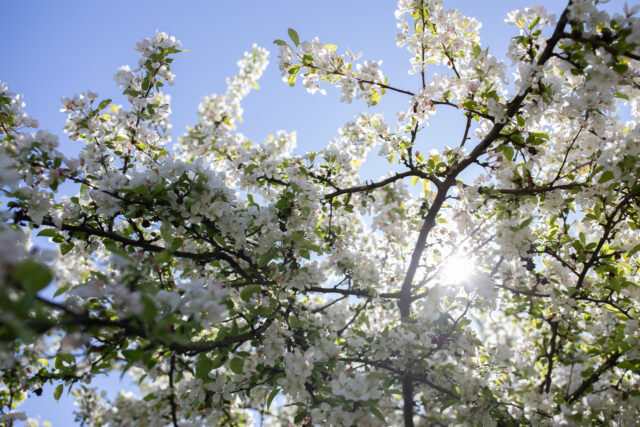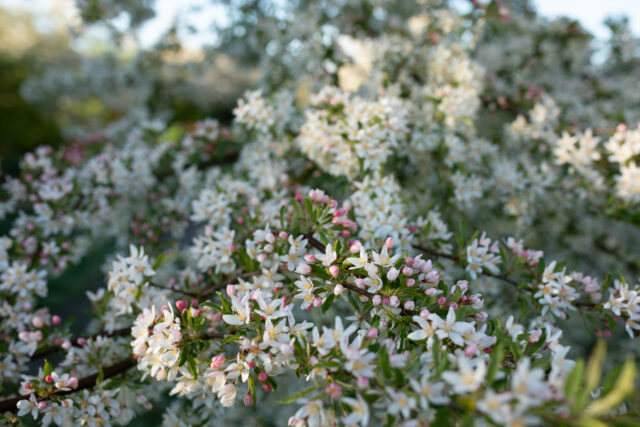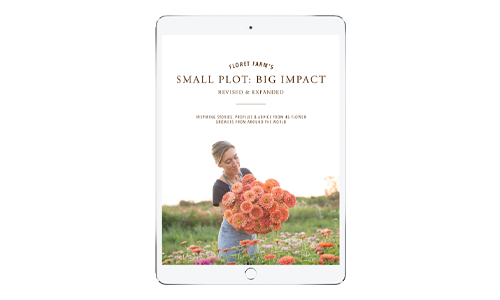There are no other trees that I know of that offer so much beauty throughout the year as crabapples—they really are a tree for all seasons.
 Each spring their fat buds explode into a cloud of fragrant blossoms. When the petals finally start to fade and a breeze comes along, it looks like it’s been snowing out in the garden. By June, the branches are covered in miniature fruit that is perfect for incorporating into arrangements or just admiring in place.
Each spring their fat buds explode into a cloud of fragrant blossoms. When the petals finally start to fade and a breeze comes along, it looks like it’s been snowing out in the garden. By June, the branches are covered in miniature fruit that is perfect for incorporating into arrangements or just admiring in place.
 As summer fades, their fruit begins to transform, and with fall’s arrival, their foliage becomes a kaleidoscope of colors. In the winter months, their bare skeletons offer a striking beauty and their remaining fruit provides food for wildlife and songbirds during the coldest time of the year.
As summer fades, their fruit begins to transform, and with fall’s arrival, their foliage becomes a kaleidoscope of colors. In the winter months, their bare skeletons offer a striking beauty and their remaining fruit provides food for wildlife and songbirds during the coldest time of the year.
 Every season my love for them grows, and I plant as many new varieties as I can possibly find here on the farm. We now have more than 94 cultivars spanning nearly 300 trees! If you’d like the full list of our collection (which also includes sources), scroll to the bottom of this post and enter your email address.
Every season my love for them grows, and I plant as many new varieties as I can possibly find here on the farm. We now have more than 94 cultivars spanning nearly 300 trees! If you’d like the full list of our collection (which also includes sources), scroll to the bottom of this post and enter your email address.
 Most of our trees are still quite young so it’s hard to know which varieties will rise to the top just yet, both ornamentally and for culinary uses like cider, jelly, baking, and fresh eating. But as the trees mature, I’ll be sure to share more about my findings. Below you’ll find a few of my favorites so far.
Most of our trees are still quite young so it’s hard to know which varieties will rise to the top just yet, both ornamentally and for culinary uses like cider, jelly, baking, and fresh eating. But as the trees mature, I’ll be sure to share more about my findings. Below you’ll find a few of my favorites so far.
‘Chestnut’
Vigorous trees are healthy, fast growing, and early to flower. They produce small fruit (about the size of a golf ball) and are loved by everyone—especially the kids who visit the farm. Mild and slightly tart, the fruit is excellent fresh and tastes like applesauce. ‘Chestnut’ is one of the first crabapples to ripen.
‘Dolgo’
We planted this gem about 15 years ago in our backyard and it continues to impress. The tree has a sprawling habit, with beautiful blush buds and creamy flowers in the spring. The oblong fruit ripens in August and has a wonderful flavor that is great both fresh and cooked.
 ‘Evereste’ (pictured above)
‘Evereste’ (pictured above)
If I could only grow one crabapple, this would be it! The trees are a nice manageable size, topping out at about 12 ft—ideal in a smaller garden. Every April they become a cloud of creamy, double, highly fragrant blooms that persist for weeks. Marble-sized fruit appears in June and begins to color up by July, transforming from green with a blush wash, to orange, and eventually ruby in autumn. I cut fruiting branches all season and tuck them into as many bouquets as I can. The best part is that the tiny apples are firmly attached and don’t fall off when handling. Fruit is very tart and slightly astringent but once fully ripe would be a great addition to sauce or cider.
‘Golden Hornet’
I spent years trying to track this tree down and it’s no wonder why it’s such a popular variety in England. The trees are healthy and vigorous, and fruit at a very young age. The marble-sized apples are a glowing yellow and ripen very early in the season. So far I’ve only tasted them past their prime, when the flesh is mushy, but I’m guessing that if caught early they could be good for cooking.
 ‘Golden Raindrops’ (pictured above)
‘Golden Raindrops’ (pictured above)
One of the most beautiful crabapples we grow, this vigorous, healthy tree gets quite large and puts on an amazing show each spring. Branches are long and slender and grow horizontally, giving trees a very rounded shape. The last to flower, thousands of creamy star-shaped blooms burst into a fragrant cloud which the bees go absolutely mad for. You can literally hear the trees buzzing from across the garden. Their leaves are maple-shaped and turn bright gold in the autumn right before dropping to reveal the tiny yellow bead-sized fruit decorating each branch. They aren’t really edible (too small and sour) but the wildlife just love them, especially songbirds.
 ‘Puget Spice’ (pictured above)
‘Puget Spice’ (pictured above)
This variety was bred right here in Washington at Washington State University and scores extremely high on disease resistance. The compact trees have a very conical, upright growth habit making them a great choice as a street tree or where space is limited. It’s one of the latest to flower for us and is covered in beautiful soft pink blossoms that have a light scent. The fruit is a bit larger than a cherry and has a zingy, tart flavor that would be great in cider or jelly. We eat them fresh but prefer them cooked.
‘Sargent’
One of the prettiest varieties that flowers each spring, these compact, well-behaved trees would be the perfect addition to a small yard. One of my favorites for cutting, the long slender branches are covered in tiny peachy-blush buds that open to miniature creamy blooms. Bees love it too! The cranberry-red fruit is small, ripens very early, and while not good for eating, the wildlife love it.
 On our crabapple list, you’ll find a handful of very special Sweetmeat Crab™ varieties bred by Albert Etter at the turn of the century. These varieties are a class of small dessert/cider apples and are said to have “intense, robust flavor in a small package.”
On our crabapple list, you’ll find a handful of very special Sweetmeat Crab™ varieties bred by Albert Etter at the turn of the century. These varieties are a class of small dessert/cider apples and are said to have “intense, robust flavor in a small package.”
When Albert died in 1950, his experimental apple orchard fell into decay and neglect until Ram and Marissa Fishman (owners of Greenmantle Nursery) went on a mission to save his trees and decades’ worth of breeding work. They offered Etter’s treasured trees, both his named and trial varieties, in their catalog for many years. Sadly, Ram passed away a few years ago and these trees were nearly lost again. Thankfully, Trees of Antiquity has added them to their offering to ensure they will survive for generations to come.
While I haven’t yet tasted these delightful varieties, I’ve spent almost a decade reading stories about them and patiently waiting for trees to become available. We now have 50 of Etter’s varieties (including both the Sweetmeat™ and red-fleshed Rosetta™ hybrids) in our very own orchard and I’ll share more about them once they set fruit.
Greenmantle Nursery has some wonderful posts on their website about Albert Etter that would make wonderful winter reading. If you read the series about Albert and his trees, you won’t be able to resist adding one of his varieties to your garden!
FAVORITE SOURCES
If you’d like to add crabapples to your garden or farm, here are some of our favorite sources for trees. Late fall to early winter are the best times to pre-order since you’ll find the largest selection. Bare root trees are shipped in early spring, sometime between March and May, depending on your location. Be sure to check with local nurseries too since many carry bare root fruit trees in the winter and they are much more affordable than potted trees.
 Mail-Order Nurseries
Mail-Order Nurseries
Blue Hill Wildlife Nursery
During my hunt for new crabapples, I stumbled onto this unique mail-order nursery located in Pennsylvania that specializes in varieties of fruit that attract whitetail deer for hunters. I’d never heard of anyone wanting to attract deer to their property! Owner Ryan Haines has been working on a collection of fruit varieties for more than 20 years that produce abundantly from a young age, are disease resistant, cold tolerant, flavorful, and very easy to grow. While he offers many different types of standard-size fruit and nut trees, his crabapples and applecrabs (large-fruited crabs) look amazing. If you aren’t easily offended and want a good chuckle, the names of some of the trees are pretty funny, including ‘Deer Candy’, ‘Road Kill’, and ‘Lockdown’. One thing to note is that trees only go on sale once per year in the fall, so be sure to use the “get alert feature” and put the sale date on your calendar because he sells out very fast.
Burnt Ridge Nursery & Orchards
This long-standing, family-owned farm located in Onalaska, Washington specializes in northwest-native plants, fruit and nut trees, and a wide selection of ornamental trees and shrubs that are both fruiting and flowering. I’ve been ordering from this wonderful company for two decades now and I’m always thrilled with my order.
Cummins Nursery
This small, New York-based nursery grows and ships thousands of fruit trees from their farm each year. They have a great selection, including lots of stone fruit, cherries, pears, and many types of apples—from red flesh to heirlooms to cider—and a good dozen crabapple varieties, too. I’ve always been really happy with everything I’ve ordered from them and love their tagline: “fruit trees for everyone.”
Fedco Seeds
This long-standing, Maine-based nursery specializes in varieties that perform well in cold climates. In addition to offering seeds, potatoes, onions, bulbs, and growing supplies, they also have a great selection of fruiting plants and trees. I’ve gotten a number of really special heritage varieties from them, including almost a dozen different crabapples. Their bare root trees are tiny when they arrive but will take off quickly once in the ground.
 Orange Pippin Fruit Trees
Orange Pippin Fruit Trees
Orange Pippin offers more than a dozen great crabapple cultivars including the rare (here in the States) ‘Golden Hornet’ variety. I’ve been very pleased with the quality of their trees.
Raintree Nursery
This specialty nursery located in Morton, Washington has an incredible selection of fruit trees, nut trees, unusual edibles, and berries, all of which have been carefully selected to thrive in the Pacific Northwest. They also offer native plants, ornamental trees, shrubs, and vines.
St. Lawrence Nurseries
This nursery is one of my very favorites and has an amazing selection of fruit trees and fruiting plants. Located in Potsdam, New York, St. Lawrence is one of the only nurseries growing their stock in an extreme climate (zone 3), so anything you get from them will survive even the toughest growing conditions. I love that their tagline is “cold hardy plants for cold hardy people.” Owners Connor and Allyssa use organic, regenerative growing methods and all of their trees are planted, tended, and dug by hand to ensure the highest quality. Be sure to sign up for their mailing list (email [email protected] with your address) in order to get their wonderful printed catalog. It’s filled with stories, art, and colorful descriptions and is worth hanging onto because someday it’s sure to be a collector’s item.
Trees of Antiquity
This treasured mail-order nursery has been growing and shipping heirloom fruit trees around the country for more than 40 years. Their collection is unmatched, with 200 different historical apples available this season alone, including many of the Sweetmeat™ and Rosetta™ varieties bred by Albert Etter. If you search “Etter” on their site, all of these special varieties will come up. In addition to their incredible preservation efforts, Trees of Antiquity is also certified organic. I’ve been very impressed with their quality and selection and am excited to continue adding more of their varieties to our farm in the future.
 Local Western Washington Nurseries
Local Western Washington Nurseries
Biringer Nursery
Located here in the Skagit Valley, Biringer Nursery has been growing flowering ornamental trees and shrubs, along with a wide selection of fruit trees for the wholesale trade, since the early 1970s. They specialize in wholesale bare root plants that are available during the winter months. Getting them on the phone can sometimes be tricky, but be persistent. They offer one of the best selections of French lilac cultivars and crabapples I’ve found.
Christianson’s Nursery
If you’re within driving distance of the Skagit Valley this family-owned nursery is a must-visit. Of all the plant nurseries I have gone to, Christianson’s is hands down the best. In addition to having an amazing selection of specialty perennials, annuals, shrubs, and trees, they also have the largest selection of garden roses in the state. Bring your checkbook and plan to stay for a couple of hours!
Clark’s Native Trees
This Arlington, Washington-based nursery specializes in trees and shrubs native to western Washington. Plants must either be picked up at their nursery or, if you have a large enough order, they will deliver. We planted a huge native hedge along the back property line of our farm using plants from Clark’s and have been very pleased with how well they established and took off.

If you have a favorite crabapple variety or source you think we should know about, I’d love to hear about it in the comments section below.
Please note: If your comment doesn’t show up right away, sit tight; we have a spam filter that requires us to approve comments before they are published.
Floret only lists companies and products that we love, use, and recommend. All opinions expressed here are our own and Floret does not offer sponsored content or accept money for editorial reviews. If you buy something using the retail links in this post, Floret may receive a small commission. Thank you for your support!







Margo on
We have a Malus ‘Evereste’, and we love the flowers and fruit. So do the deer, who eat the fruit standing on their hind legs. They have caused the tree to tilt toward the house, thanks to rubbing off velvet and bracing themselves on the tree. I did not expect it to get as wide and tall as it has – I recommend planting them about 20′ from the house, as 12-14′ feet is not far enough.